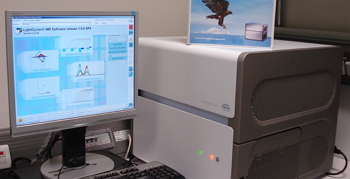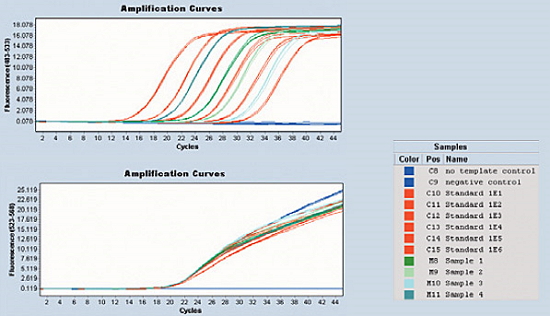DIAGNOSIS OF PERIDONTAL INFECTIONS USING THE TECHNIQUE OF POLYMERASE CHAIN REACTION (PCR) IN THE QUALITATIVE AND QUANTITATIVE MODALITY
|
Description |
Molecular biology techniques for the detection and / or quantification of pathogenic bacteria associated with periodontal diseases. Molecular biology has become a very useful tool in the practice of the current dentistry allowing the study of microbial communities in the oral cavity, including species which are not likely to be grown in the laboratory. These techniques are based on the characterization of nucleic acid molecules. Allow to reach the rapid diagnosis of infectious diseases in cases where conventional diagnosis can´t be used. They have also proved useful results in the field of epidemiology, as they make possible the knowledge of the likely source of infection, mode of transmission and the gateway of the microorganisms involved in the infection.

LightCycler® 480 II (Roche), laboratory equipment, Faculty of Dentistry, UCM.
|
How does it work |
For application, the first step is the collection and preparation of the samples, considering the conditions of collection, storage and transport. Usually, the microbiological samples will be taken from locations evaluated by a specialist with sterile paper points. These paper points will be deposited in a vial containing a sterile reduced transport fluid (RTF), preserving the anaerobiosis.

Example of an absolute quantification assay using the LightCycler® 480 II (Roche), performed in the research laboratory of the Faculty of Dentistry, UCM.
After a maximum period of 24 hours from collection until receipt at the laboratory, samples will be dispersed, and we will proceed to the extraction and purification of deoxyribonucleic acid (DNA), to perform then the specific analysis by PCR technique. Different DNA-based protocols will be used, based on particular chemical, enzymatic and / or physical agents to release the genetic material depending on the characteristics of the samples. It continues with the purification of the extracted material, and then it will be subjected to amplification techniques, either by the technique of qualitative PCR, using specific primers for selected bacteria, or by quantitative PCR with incorporation plus fluorescent label for quantitation of these bacteria in samples. These techniques allow us to detect and quantify, specifically and with high sensitivity, possible periodonto-pathogens in oral samples.
|
Advantages |
It is a clear support in the diagnosis and treatment of periodontal diseases.
|
Where has it been developed |
This technique has been developed in the Laboratory of Periodontal Research, Department of Stomatology III, Faculty of Dentistry. The research laboratory is using the techniques of molecular biology for research aim and as a support in the diagnosis of periodontal diseases. The laboratory offers to researchers an assortment of options, conducted by highly qualified staff and high-performance equipments. The laboratory provides technical and analytical advice in these samples, also participating in the progress of the study and development of new methodologies in this field.
|
And also |
The technology exposed provides assistance in research and to clinicians in two ways:
• Expand the knowledge of the microbiological events that occur in the oral cavity in the field of dental research.
• Assist in the diagnosis and treatment of their patients to clinicians, by obtaining advice based on microbiological analysis of samples.
|
Contact |
|
© Office for the Transfer of Research Results – UCM |
|
PDF Downloads |
|
Classification |
|
Responsible Researcher |
Mariano Sanz Alonso: marianosanz@odon.ucm.es
Department: Stomatology III
Faculty: Dentistry


